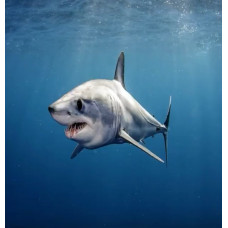Latin name
Glyphis gangeticus
Other name
Glyphis gangeticus
Identification
The Ganges shark is stocky, with two spineless dorsal fins and an anal fin. The snout is broadly rounded and much shorter than the width of the mouth. The mouth is long and wide, extending backwards and upwards towards the eyes. The upper teeth have high, broad, serrated, triangular tips and the lip furrows are very short. The lower front teeth have long, hooked, protruding cusps with serrated cutting edges along the entire length of the cusp, but without spear-like tips and with low cusps on the soles of the crowns. The number of tooth rows is 32-37/31-34. A longitudinal upper anteromedian fossa is visible, but there is no interorbital protrusion.
Features of fish fins
The first dorsal fin of these sharks begins above the last third of the pectoral fins, and the free posterior end is well in front of the pelvic fins. The second dorsal fin is relatively large, but much smaller than the first (about half the height). The anal fin is slightly smaller than the second dorsal fin and the pectoral fins are broad.
Fish colouring
The Ganges shark has a uniform grey to brownish colouration with no distinctive markings.
Distribution
It is a rare species. Its range includes the Hooghly River, the Ganga river system, West Bengal, Karachi and Pakistan. There is evidence of its presence on the island of Taiwan.
Habitat
This species is found only in freshwater, coastal marine and estuarine waters.
Size
The Ganges shark ranges in size from 22 to 24 inches (56 to 61 cm) at birth, to about 70 inches (178 cm) at maturity, with a maximum size of about 80 inches (204 cm).
Behavior
With the limited visibility that characterises many tropical rivers and estuaries, other senses such as hearing, smell and electroreception are likely to be used by these sharks for predation. Because the shark's eyes are on its back rather than on the sides or bottom, it can swim along the bottom and scan the water above it for potential prey illuminated by the sun from behind.
Food and feeding habits
The eyes of the Ganges shark are flattened at the top, rather than laterally or from below as in most grey sharks, probably indicating that this species stays close to the bottom and can track prey against the sun. Its small eyes and fine teeth suggest that it is adapted to the murky waters of the Ganges and Bay of Bengal. There is unconfirmed evidence that in the Bay of Bengal these sharks prey mainly on stingrays Dasyatis longa, which spend most of their time on the bottom.
Reproduction
This shark is probably viviparous with a placenta in the form of a yolk sac. Newborns are 56-61 cm long. Their life cycle is probably similar to that of other river sharks, characterised by long gestation, slow growth, delayed maturation and small brood size.
Fishing
The artisanal fishery for the Ganges shark is widespread, although scattered. It is important for both local consumption and international trade. The Indian government has banned fishing for this species.
Relationship with a person
The Ganges shark has a reputation as a ferocious cannibal, but it is likely that most of the attacks attributed to this species are actually carried out by bull sharks. The teeth of these sharks are more adapted to catching fish, whereas the teeth of the bull shark are adapted to dismembering the bodies of marine mammals.
| Classification | |
| Phylum | Chordata |
| Class | Chondrichthyes |
| Squad | Carcharhiniformes |
| Family | Carcharhinidae |
| Genus | Glyphis |
| Species | G. gangeticus |
| Features | |
| Conservation status | Critically Endangered |
| Habitat | Pelagic |
| Life span, years | No information |
| Maximum body weight, kg | No information |
| Maximum length, cm | 204 |
| Sailing speed, m/s | No information |
| Threat to people | Edible |
| Way of eating | Predator |
Ganges shark
Tags: ganges shark


